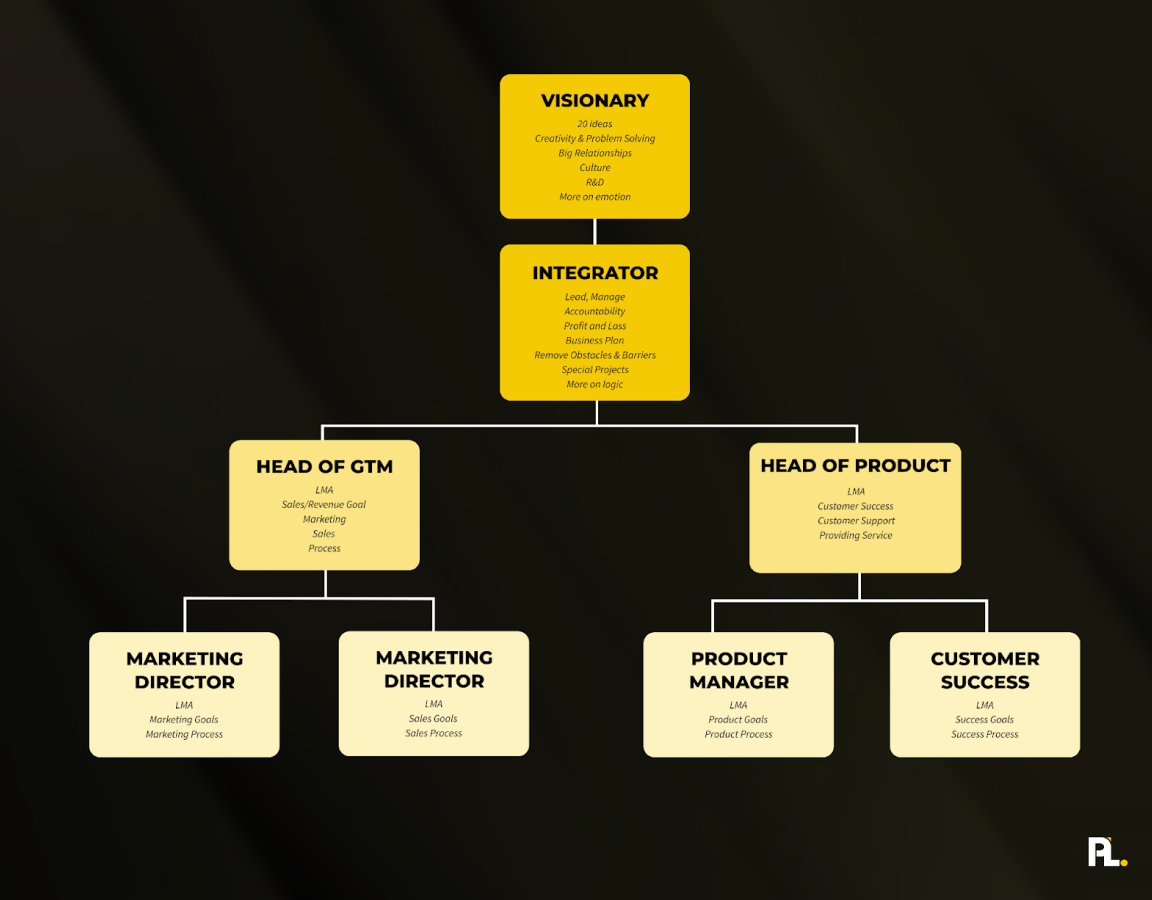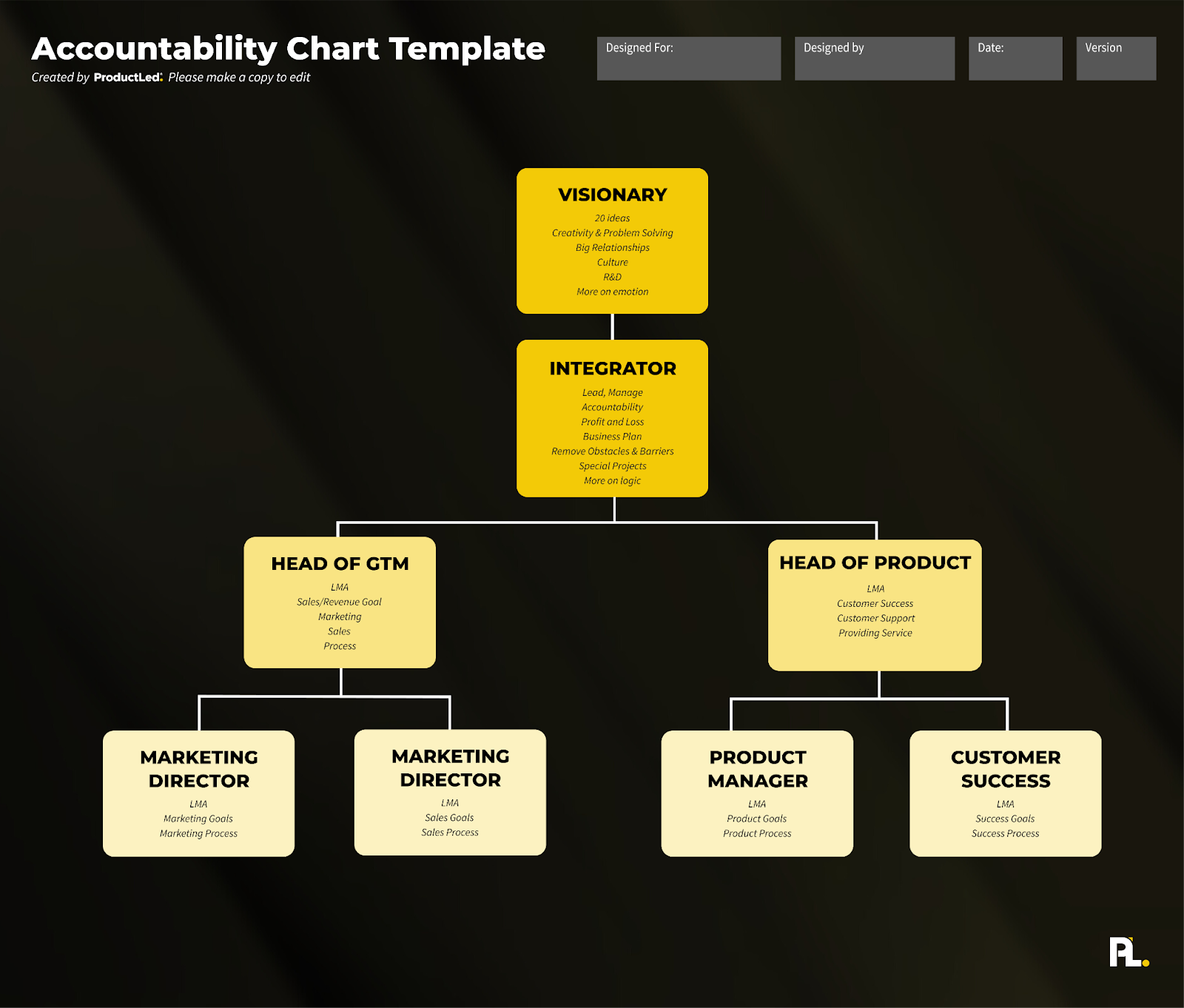
Behind every winning SaaS product is a dream team.
As you’ll learn in this article, every team member should excel at what they do and play a precise role in fueling the product’s growth.
Accountability charts are a great tool for gaining a clear insight into who is responsible for what. This clarity can fast-track the alignment of everyone’s efforts and address common problems like burnout.
Plus, I’ll provide an accountability chart template you can tailor to your product-led business.
Let’s get started.
What is an accountability chart?
An accountability chart is a tool designed to outline details of the hierarchy and responsibilities of who does what in your product-led organization.
Here’s an example of an accountability chart showing what one looks like.

It differs from a traditional organizational chart because team members can be listed multiple times to reflect the many roles or "hats" they wear within a company. This is particularly useful for small to medium-sized product-led businesses where roles often overlap and individuals take on multiple responsibilities.
An accountability chart helps clarify roles and responsibilities, making it easier to see areas of opportunities.
Accountability chart vs. organizational chart
Here's a brief comparison between the org and accountability charts to clarify any lingering confusion.

Why product-led companies benefit from accountability charts
Visualizing team responsibilities through accountability charts lets founders assess each role a person plays within their organization.
This birdseye view of a company can benefit its team structure by:
- Provides clear roles and responsibilities to reduce confusion and prevent burnout
- Aligns team efforts with the company's growth phases.
- Identifies gaps and overlaps so all tasks are covered efficiently
- Supports sustainable growth with strategic hiring insights
- Ensures a mix of skills by hiring for weaknesses and encouraging diversity.
If you follow the ProductLed System™️, you know the Team component is last to ensure the company optimizes their product for growth, user acquisition, and retention first.
This strategy framework reduces early hiring (a common founder mistake), so the focus is on making the product the main driver of success. You only want to add new talent when your product-led organization is solid and scalable.
Okay, now that we’ve reviewed the benefits, let’s map out your business's accountability chart.
Free accountability chart template
To get started, here’s a free template.

Let’s look at some of the key roles included in this accountability chart.
Visionary
This is typically the founder or CEO. They set the overall vision and strategy for the product-led company: define long-term goals, set the company culture, and ensure the organization’s direction aligns with its mission and market opportunities.
Integrator
The Integrator or Chief Operating Officer (COO), manages the day-to-day operations. They tackle immediate challenges while planning for the next three to six months, setting the direction and company pace.
Build out your company’s accountability chart
First, assess how your current team members fit into your accountability chart template.
Identify the person who is:
- Your Visionary
- Your Integrator
- Your leadership team
- All management and specialties who support your leadership team
Next, schedule a six to 90-minute meeting to discuss and gather insights on everyone’s roles and responsibilities.
Ask each team member to write down all the “hats” they wear beforehand.
During the meeting, compile these lists to see the full scope of responsibilities, noting where they overlap or where there are gaps in your team’s structure. Doing so provides a clearer understanding of each person’s roles within your team.
Next-level color-coded accountability charts
If you want to improve your accountability chart, you can add simple color-coding to clarify team structure priorities.
Use red to identify roles that overwhelm team members and indicate growth opportunities.
Use yellow to mark urgent tasks that require immediate filling.
This will help you to identify the top one to three critical hires or contractor opportunities necessary to strengthen your team.
Product-Led Mindset for the Win
The true magic of a product-led business lies in its ability to achieve lean scale—growing your SaaS product with a small, elite team.
Avoid the common trap of over-hiring the moment you hit your first six- or multiple six-figure months. Instead, take a strategic approach by fine-tuning your accountability chart using the four Ts:
- Trim roles that are no longer essential
- Trash outdated positions
- Treasure roles that add real value
- Transfer tasks to someone with more time or motivation
If you treat your employees like family, you’ll likely build a well-meaning but average business. But if you build your team like a winning sports team, every hire becomes a strategic asset—an A-player with a clear role in helping you win.
Creating accountability charts falls under the Team component of the ProductLed System™—the final piece in building a repeatable growth engine that can 2x your self-serve revenue in under a year.
The evidence is clear: PLG reduces costs, improves efficiency, and creates long-term competitive advantages. Companies that wait risk falling behind more agile competitors.
If you're ready to take the next step:
✅ Learn how to design a high-performance SaaS team
✅ Explore the nine components of the ProductLed System™
✅ Work with a coach and join ProductLed Academy
✅ Take the PLG Readiness Assessment
✅ Explore Implementation Options
Because behind every great product is a great team—and behind every great team is a clear growth strategy.























